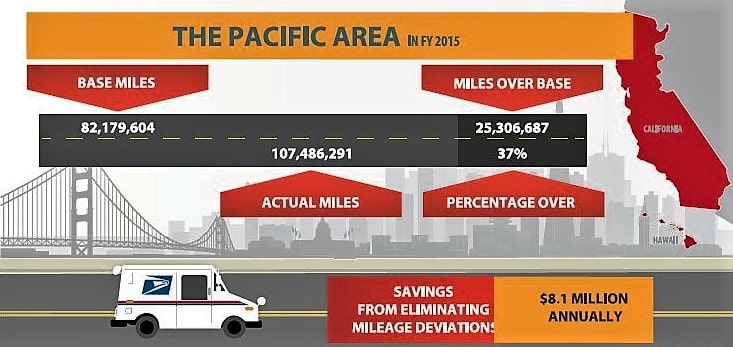Background
The U.S. Postal Service delivers almost 154.2 billion pieces of mail annually using one of the largest vehicle fleets in the country with over 214,933 Postal-owned vehicles. In fiscal year (FY) 2015, postal-owned delivery vehicles traveled over 1 billion miles nationwide, about 190 million miles more than initially estimated.
Postal Service supervisors and managers use the Delivery Operations Information System (DOIS) and the Automated Vehicle Utilization System (AVUS) to help them manage carrier operations and mileage on delivery routes.
Delivery routes are a scheduled course to be followed in performing delivery duties. The Postal Service generally establishes the route’s base miles twice each year; as part of the annual route inspection for city delivery and during the National Rural Mail Count for rural delivery.
The DOIS records the authorized base miles for carrier routes and the AVUS manages day-to-day vehicle use. The AVUS allows carriers to enter vehicle mileage information into Intelligent Mail® Devices, or scanners, at appropriate points along their routes. At the end of the route, the AVUS calculates hourly vehicle use, and compares miles driven to authorized miles for the route. Delivery unit supervisors use this information to ensure that carriers are not deviating from the line of travel for their routes.
The Pacific Area has eight districts and 18,998 delivery routes. The Pacific Area’s route base miles, established in FY 2015, were 82,179,604 and its mileage variance—the difference between the base miles and actual miles — was 25,306,687 miles (30.79 percent), the highest variance percentage in the country.
Our objective was to evaluate the accuracy of delivery route mileage data in the Pacific Area.
What the OIG Found
The Pacific Area’s delivery route mileage data was not always accurate. Route base mileage data for 37 percent (6,955) of the Pacific Area’s routes had inconsistent base route mileage between the AVUS and the DOIS as of June 8, 2016. Furthermore, actual daily miles recorded in the AVUS exceeded the AVUS route base miles by over 26,000 miles with no justification for the deviations.
These conditions occurred because supervisors were not trained to maintain route base miles, or monitor and document daily mileage use and deviations.
Accurate mileage data established at the route inspection and adjustment and managing and monitoring daily mileage are critical to manage vehicle use. We estimated inaccurate base mileage cost the area more than $8.1 million in questioned costs in FY 2015, and eliminating mileage deviations could further reduce area costs by more than $8.1 million annually.
What the OIG Recommended
We recommended management train existing, newly promoted, and temporary supervisors on maintaining route base mileage, and monitoring and documenting daily mileage use and deviations.
Read full report
Source: USPS Office of Inspector General

